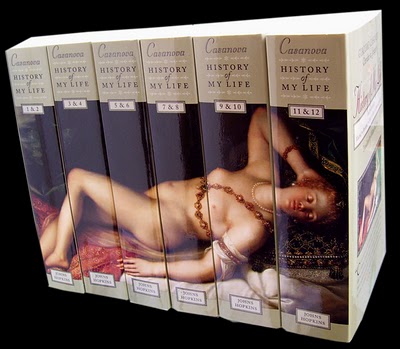“After that we went from one casino to another, not intending to commit any debauchery, but for want of something better to do.”
 In the field of playing the field, Giacomo Casanova (1725-1798) was a giant who gave his name to generations of comparative midgets – guys who couldn’t pretend to attain the lofty standard he set for both quality and quantity. For The Original, the highly intelligent, well-educated offspring of an Italian actor and actress, no effort, ingenuity, or gold was to be spared in pursuit of a date – or “asssignation” as it was then styled.
In the field of playing the field, Giacomo Casanova (1725-1798) was a giant who gave his name to generations of comparative midgets – guys who couldn’t pretend to attain the lofty standard he set for both quality and quantity. For The Original, the highly intelligent, well-educated offspring of an Italian actor and actress, no effort, ingenuity, or gold was to be spared in pursuit of a date – or “asssignation” as it was then styled.
Casanovas aren’t what they used to be. Such is the conclusion I’ve arrived at as I near the end of volume 2 (of 12!) of the work, one of the authentic literary monuments of the eighteenth century and a real trove of detail about the pursuits, politics, clothing, domestic arrangements, and, of course, gender relations of the Europeans who lived it. Food and wine figure prominently here either as accompaniments to seduction or the actual instruments thereof. Remind me to tell you the one about Emilie, Armelline, and the one hundred Venice oysters.
With the aid of an electronic version of the memoirs (courtesy of Project Gutenberg) I was able to note each instance of wine mentioned in its 2679 pages.
Many are likely to be familiar to the 21st century reader, namely: refosco, muscatel, muscat, Champagne (lots of this), red and white Burgundy including Chambertin (“Truly Chambertin and Roquefort are excellent things to restore an old love and to ripen a young one.”), Bordeaux, Malaga, Tokay, Rhine (or Rhenish), alicante, Cape (South Africa), La Mancha, Montepulciano, Montefiascone, Languedoc (as Beziers), Orvieto, Hermitage, Gatta, Neuchatel, aleatico (as “Oleatico”).
Other varieties cited still exist, but are scarcely the stylish sips they used to be. Among these: Madeira, Malmsey, Cyprus (assume this is the sweet, luxury wine known as Commandaria), Sillery (a species of Champagne, though perhaps still rather than sparkling), Ratafia (a wine-based cordial), and Canary (AKA Canary Islands, whose wine may now in process of making a comeback), Samos and Cephalonia (from islands in the Aegean and Ionian seas, respectively).
Still other wines seem permanently consigned to oblivion. Who today has any idea what Cerigo, Scopolo, or generoydes were or tasted like?
Gem-quality anecdotes and quotable quips are thick on the ground here, and even the occasional remarkably sound admonition. For example, who today, beset by claims of winemakers that their wines are pure, natural, organic, biodynamic, more pristine than Adam and Eve before the Fall, could fail to be tickled by this indignant outburst:
You stupid fellow,” I exclaimed, “how can you ever be certain of the purity of wine unless you have made it yourself?”
(This post was first published in January of 2012)
Reach me at stephenmeuse@icloud.com
Follow Stephen Meuse